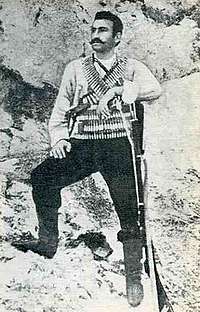Kevork Chavush
Kevork Ghazarian (Armenian: Գէորգ Ղազարեան; 1870 – 27 May 1907) commonly known as Kevork Chavush or Gevorg Chaush (Armenian: Գէորգ Չաւուշ), was an Armenian fedayee in the Ottoman Empire.
Kevork Chavush | |
|---|---|
 Kevorg Chavush's only photo, taken in 1904 by Vahan Papazian (Goms) in Aghtamar Island, just before the meeting of fedayees. | |
| Birth name | Kevork Aroyi Ghazarian |
| Nickname(s) | The Lion of Mountains (Սարերու Առյուծ) |
| Born | 1870 Bsanats, Bitlis Vilayet, Ottoman Empire |
| Died | 27 May 1907 (aged 36–37) near Solukh, Bitlis Vilayet, Ottoman Empire |
| Allegiance | |
| Years of service | 1890—1907 |
| Battles/wars | Armenian National Liberation Movement 1894 Sasun Resistance Battle of Arakelots (1901) 1904 Sasun Uprising |
Kevork Chavush was a legendary fedayee whose main goal was to ameliorate the plight of the Armenian peasantry in the face of harassment by marauding Turks and Kurds. To this end, he advocated armed resistance. Chavush's extraordinary daring and valor inspired his men as he led the resistance in the region of Daron-Sasun from 1904 until 1907, when he was killed in battle. Kevork Chavush was known to have good relations with some Kurdish leaders of the region. He would openly meet and dine with them and at the same time, try to persuade them to not obey orders by the Sultan, who had hired the Kurds as part of his Hamidieh guards. This was in vain as the Kurds ended up not joining the Armenian revolutionaries.[1] Kevork Chavush, is called "the man with the dagger who was always ready to punish those who molested the defenseless people."[2]
Early life
Kevork Chavush was born to a family of hunters in Sasun, in the village of Mktink in the Bsanats region.[3] He received his education in Mush's Arakelots monastery's school. He left school to join Arabo, a leading fedayee at the time. After Arabo was arrested, Chavush tracked down Arabo's traitor and assassinated him.[4] From 1885 to 1888, he travelled to and found residence in Aleppo. He worked to raise enough money to buy a rifle. He returned to Taron in 1890 to join his friend Hampartsoum Boyadjian's group of Armenian fighters with the aim to defend Armenian-populated villages from Hamidian persecutions.[1]
Sasun Resistance and death

In 1894, he participated in the Sasun Resistance against the Hamidian persecution of Armenians. During the battle, Chavush was captured and sentenced to jail for 15 years. He managed to escape from jail 2 years later and fled to the mountains of Sasun, where he joined the Dashnaktsutyun political party with friends and pursued revolutionary movement against Turkish officials. In 1896, he met Andranik Ozanyan and participated in various battles, most notable the Second Sasun Resistance in 1904.[5] During his career as a freedom fighter, he was also placed under the command of Serob Aghpyur. During this time, Kevork Chavush's uncle ran into trouble with the guerrillas when he nabbed a woman from a different Armenian village. The case was brought upon Serob Aghbyur who subsequently turned to Chavush and said "Kevork, your uncle is the guilty one, you decide upon his fate" (Armenian: «Գէորգ քու հօրեղբայրդ է յանցաւորը, դո՜ւն դատէ ու վճռէ:»). Chavush executed his kidnapping uncle but suffered from a severe depression afterwards and isolated himself in order to grieve the loss of his uncle.[1]
Kevork Chavush was critically wounded on 25 May 1907 during a large firefight at the Battle of Sulukh with the Ottoman army in Sulukh, Mush and which forced him to escape the fighting. Two days later his body was found in Kyosabin-Bashin on 27 May under a bridge. Kevork Chavush remained a leading Armenian guerrilla until his death. To the Armenian people he is a symbol of pride and hope for Armenia to be free and independent from foreign rule. He is considered a great hero to the Armenian nation and her national movement. Chavush was buried in the Armenian cemetery of Kogh.
Legacy
The Kevork Chavoush Museum is located in the village of Ashnak. Additionally, he has a song made in his honor.
Gallery
- Statue of Chavush near Khor Virap
 A 1910 postcard (front) portraying the widow of Kevork Chavush, Heghine. On the front of the postcard is the black-and-white image of a woman in a long black dress; she’s holding a handgun in her right hand and a rifle in her left. Bandoliers are wrapped across her chest and around her waist. Nearly lost among the bullets and leather is a round brooch or medallion above her left breast.
A 1910 postcard (front) portraying the widow of Kevork Chavush, Heghine. On the front of the postcard is the black-and-white image of a woman in a long black dress; she’s holding a handgun in her right hand and a rifle in her left. Bandoliers are wrapped across her chest and around her waist. Nearly lost among the bullets and leather is a round brooch or medallion above her left breast. Back of postcard, reading "Deceased hero Kevork Chavoush’s Wife, the widow Heghine."
Back of postcard, reading "Deceased hero Kevork Chavoush’s Wife, the widow Heghine."- Taken on the Sulukh bridge on the River Aratsani. Kevork Chavush was critically wounded here on May 25, 1907, during a battle with the Ottoman army and died two days later.
References
- Kurdoghlian, Mihran (1996). Hayots Badmoutioun (Armenian History) (in Armenian). Hradaragutiun Azkayin Oosoomnagan Khorhoortee, Athens Greece. pp. 70–71.
- Lewy, Guenter (2005). The Armenian massacres in Ottoman Turkey: a disputed genocide. pp. 31.
- "Kevork Chavoush". Archived from the original on 2016-03-16. Retrieved 2014-03-10.
- "Armenia: The Survival of a Nation". Archived from the original on 2012-07-13. Retrieved 2007-11-02.
- "Kevork Chavush" (in Armenian). Archived from the original on 2007-10-17. Retrieved 2007-11-02.